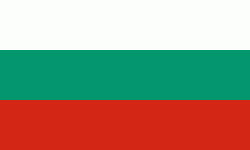Treklyano
Treklyano (Трекляно, ; also transliterated Trekljano or Trekliano) is a village in southwestern Bulgaria, part of Kyustendil Province. It is the administrative centre of Treklyano Municipality, which lies in the northwestern part of Kyustendil Province. The village is located in the Kraishte area, very close to the Serbian border and not far from the North Macedonia border. It is situated 40 kilometres north of the provincial capital of Kyustendil, 39 kilometres south of Tran and 100 kilometres west of the capital Sofia.
Treklyano lies in an isolated valley at the foot of the 1,733-metre Milevets peak in the border mountain of Milevska Planina. The Treklyano River, which runs through the village, flows into the Struma River at Zemen. The first reference to the village is in an early 15th-century Bulgarian text: ѠТ СЄЛО ТРИКЛИНО. It was also mentioned in Ottoman tax registers of 1570-1572 as Predoshnitsa or Preglino and a few years later, in 1576-1577, it was listed as Terklyane. According to popular etymology, the old village name was Tri Klena ("Three maple trees"), as there was an area near the village where three maple trees were located. Linguists suggest a derivation from *traklo, itself from trak ("tie, belt") or from Greek τρί-κλινος, "three-bedded", referring to stream beds. There is an area near the village where two rivers merge to make up a third one, i.e. forming three beds.
During the Ottoman rule of Bulgaria, the village has been abandoned and reestablished several times. There was an influx of settlers during the First Serbian Uprising of 1804, the Second Serbian Uprising of 1815-1817 and after the newly liberated Principality of Serbia included some then-Bulgarian-populated areas in 1831-1833.
The first school in the village was a monastery school founded in 1853, while a secular school was opened 10 years later. A new Bulgarian Orthodox church dedicated to the Dormition of the Theotokos was built in 1860 at the place of an older church. After the Liberation of Bulgaria, Treklyano grew rapidly: at its peak it had up to 800 houses and a population of around 4,000. A community centre (chitalishte) was established in 1901.
Treklyano municipality includes the following 19 places:
In the municipality, 1,111 people were registered in 2007, in the town there was 370 people.
Treklyano lies in an isolated valley at the foot of the 1,733-metre Milevets peak in the border mountain of Milevska Planina. The Treklyano River, which runs through the village, flows into the Struma River at Zemen. The first reference to the village is in an early 15th-century Bulgarian text: ѠТ СЄЛО ТРИКЛИНО. It was also mentioned in Ottoman tax registers of 1570-1572 as Predoshnitsa or Preglino and a few years later, in 1576-1577, it was listed as Terklyane. According to popular etymology, the old village name was Tri Klena ("Three maple trees"), as there was an area near the village where three maple trees were located. Linguists suggest a derivation from *traklo, itself from trak ("tie, belt") or from Greek τρί-κλινος, "three-bedded", referring to stream beds. There is an area near the village where two rivers merge to make up a third one, i.e. forming three beds.
During the Ottoman rule of Bulgaria, the village has been abandoned and reestablished several times. There was an influx of settlers during the First Serbian Uprising of 1804, the Second Serbian Uprising of 1815-1817 and after the newly liberated Principality of Serbia included some then-Bulgarian-populated areas in 1831-1833.
The first school in the village was a monastery school founded in 1853, while a secular school was opened 10 years later. A new Bulgarian Orthodox church dedicated to the Dormition of the Theotokos was built in 1860 at the place of an older church. After the Liberation of Bulgaria, Treklyano grew rapidly: at its peak it had up to 800 houses and a population of around 4,000. A community centre (chitalishte) was established in 1901.
Treklyano municipality includes the following 19 places:
In the municipality, 1,111 people were registered in 2007, in the town there was 370 people.
Map - Treklyano
Map
Country - Bulgaria
 |
 |
| Flag of Bulgaria | |
One of the earliest societies in the lands of modern-day Bulgaria was the Neolithic Karanovo culture, which dates back to 6,500 BC. In the 6th to 3rd century BC the region was a battleground for ancient Thracians, Persians, Celts and Macedonians; stability came when the Roman Empire conquered the region in AD 45. After the Roman state splintered, tribal invasions in the region resumed. Around the 6th century, these territories were settled by the early Slavs. The Bulgars, led by Asparuh, attacked from the lands of Old Great Bulgaria and permanently invaded the Balkans in the late 7th century. They established the First Bulgarian Empire, victoriously recognised by treaty in 681 AD by the Eastern Roman Empire. It dominated most of the Balkans and significantly influenced Slavic cultures by developing the Cyrillic script. The First Bulgarian Empire lasted until the early 11th century, when Byzantine emperor Basil II conquered and dismantled it. A successful Bulgarian revolt in 1185 established a Second Bulgarian Empire, which reached its apex under Ivan Asen II (1218–1241). After numerous exhausting wars and feudal strife, the empire disintegrated and in 1396 fell under Ottoman rule for nearly five centuries.
Currency / Language
| ISO | Currency | Symbol | Significant figures |
|---|---|---|---|
| BGN | Bulgarian lev | лв | 2 |
| ISO | Language |
|---|---|
| BG | Bulgarian language |
| TR | Turkish language |















